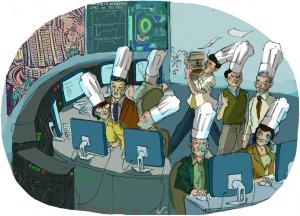Baking it hot
The tokamak cooling water system at ITER will provide just what its name suggests—cooling water to the vacuum vessel and surrounding systems to manage the heat generated during tokamak plasma operation.
Most of the time, that is ...
The system will also be designed to transport hot water and hot gas for a "baking" operation that will be planned as part of regular maintenance operations for the ITER facility.
"In much the same way that the cleaning cycle of conventional ovens uses a high-heat setting to detach grease from the oven walls," explains Raphaël Mitteau, Mechanical Engineer in the Blanket Section, "we plan to 'bake' ITER to loosen impurities that have accumulated over time on the vacuum vessel and on components facing the plasma in the divertor and on the first wall."
Isn't pumping hot water through the cooling water system a contradiction in terms?
"Planning for the cooling as well as baking operations in ITER is certainly the most challenging part of designing the cooling water system," says Giovanni Dell Orco, Senior Cooling Water System Engineer. "We'd bake to higher temperatures if we could, but we're limited by how much of a temperature and pressure differential the cooling water system components can take."
Molecules of all sorts will accumulate inside the ITER vacuum vessel, either buried in the near surface of the plasma-facing components, trapped in layers of plasma-deposited material, or "adsorbed" (deposited) on their surfaces: fuel molecules, particles from the erosion of materials, oxygen ... even trace quantities of material from the manufacturing process for the in-vessel components. Removing these contaminants is extremely important to achieving high performance in ITER, as too many impurities released from the walls during tokamak operation will pollute the plasma, causing dilution of the fusion fuels and plasma energy losses through photonic radiation.
Precious tritium can also accumulate. Tritium that goes unused during the fusion reactions makes its way to the plasma edge and can become trapped in "co-deposited" layers—that is, buried with the beryllium which the plasma erodes from the first wall and redeposits elsewhere. There are regulatory limits on how much tritium can be retained inside the vacuum vessel and control of this trapped inventory is extremely important.
"Baking does two important things," explains Richard Pitts, leader of the Plasma-Wall Interactions Group in the ITER Fusion Science & Technology Department. "It allows us to remove impurity species such as oxygen, which are lightly bound on material surfaces, improving plasma purity and performance. And it leads to the release of trapped hydrogenic species (outgassing) from both the near surfaces and the co-deposited layers. It will be an important mechanism for detritiation, especially from the divertor where we expect most of the tritium co-deposition with beryllium to occur."
Molecules which have been released from the "baked" surfaces move freely about the ITER vacuum vessel until they are removed by the ITER vacuum pumps. Spectroscopic analysis of the outgassed exhaust will allow scientists to determine exactly which molecules were removed, and in what quantities.
"In ITER," explains Raphaël Mitteau, "we're planning to bake the vacuum vessel at 200 °C, and the blanket, first wall and divertor at 240 °C, adjusting the frequency of these operations as necessary." The capability to drain water from the system from time to time and replace it with hot gas will also be provided by cooling water system engineers, allowing the ITER divertor alone—where most of the tritium is expected to be trapped— occasionally to be "baked" to higher temperatures (350 °C) than the first wall.
All tokamaks "bake" their vacuum vessels to keep the vacuum as clean as possible—each with its own in-house recipe. Some use electric heaters; others gas; still others a combination of both water heating and electric. The ITER systems have been designed to accommodate 500 "baking" events. During deuterium-tritium plasma operation, approximately 40 baking cycles are planned.
Story developed with Richard Pitts, Senior Scientific Officer; Raphael Mitteau, Mechanical Engineer in the Blanket Section; and Giovanni Dell Orco, Senior Cooling Water System Engineer.


